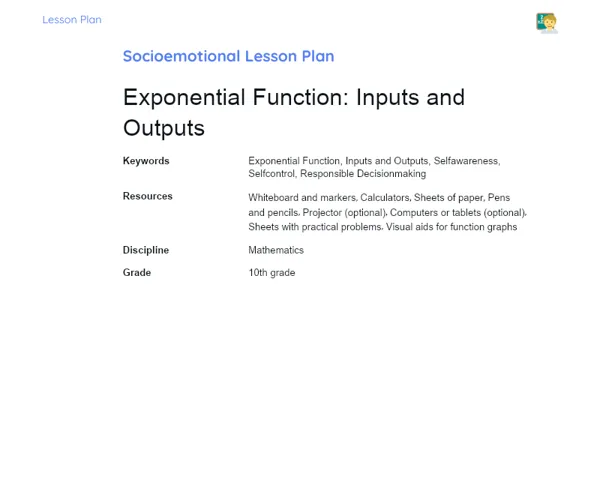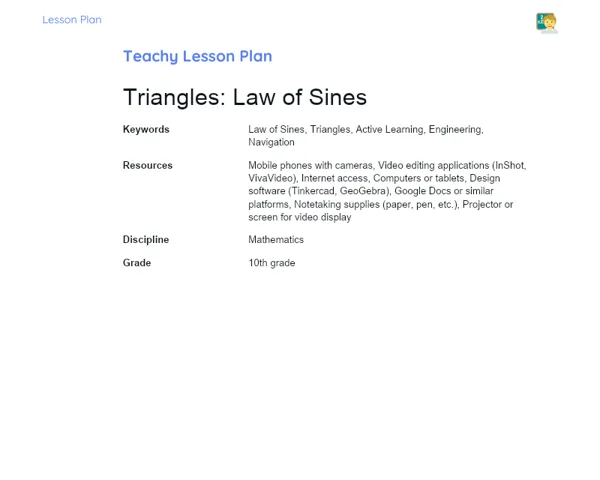Lesson Plan Teknis | Trapezoid Area
| Palavras Chave | Area of a Trapezoid, Formula, Practical Applications, Problem Solving, Trapezoidal Plot, Construction, Interior Design, Engineering, Architecture, Practical Skills, Teamwork, Measurement, Application of Math Concepts |
| Materiais Necessários | Image of a trapezoidal plot of land, Short video regarding the application of trapezoidal area calculations, Cardboard, Ruler, Scissors, Glue, Sheets for recording measurements and calculations |
Objective
Duration: 15 - 20 minutes
The aim of this stage is to introduce students to the concept of the area of a trapezoid, highlighting how this knowledge is applicable in real-life situations. Developing these skills will empower students to tackle mathematical problems with confidence and recognize the significance of mathematical concepts in their careers and everyday life.
Objective Utama:
1. Understand the formula to calculate the area of a trapezoid.
2. Apply the calculation of the area of a trapezoid to practical problems, such as plots of land or rooms with this shape.
Objective Sampingan:
- Enhance mathematical problem-solving abilities.
- Acknowledge the significance of calculating the area of a trapezoid in daily contexts and in career opportunities.
Introduction
Duration: (15 - 20 minutes)
The aim of this segment is to familiarize students with the concept of trapezoidal area, stressing the practical applicability of this knowledge. This will set the groundwork for them to approach math problems with assurance and to comprehend the value of geometric concepts in real-world scenarios.
Curiosities and Market Connection
🔍 Did You Know: The trapezoid is a geometric figure seen in many everyday and professional scenarios. In construction, for example, plots of land often have irregular shapes that must be measured accurately for proper planning and building. In interior design, you may find furniture and decor designed to fit trapezoidal spaces. 🚀 Professional Insight: Various professionals such as architects, engineers, and land surveyors frequently use trapezoid area calculations for land evaluations and designs. Knowing how to compute these areas accurately can greatly influence the success of a project.
Contextualization
Imagine you are an architect tasked with calculating the area of a trapezoidal plot to construct a new building. Or consider a cricket field that doesn’t follow a perfect rectangular shape and is rather trapezoidal. Mastering the method to calculate the area of a trapezoid is crucial for tackling such practical challenges, often encountered in professions like architecture, engineering, and design.
Initial Activity
📝 Initial Activity: Present students with an image of a trapezoidal piece of land and ask: How would you determine the area of this land? Next, play a brief video (3-5 minutes) that showcases the practical application of trapezoid area calculations in construction projects.
Development
Duration: (35 - 40 minutes)
This stage is designed to reinforce students' comprehension of trapezoidal area calculations through practical and collaborative activities, fostering reflection on the real-world application of this knowledge, and assessing understanding through problem-solving exercises.
Topics
1. Definition and properties of trapezoids
2. Formula for calculating the area of a trapezoid
3. Real-world applications of the trapezoid area calculation
4. Problem-solving skills related to the area of a trapezoid
Thoughts on the Subject
Encourage students to think about how understanding the formula for the area of trapezoids can assist them in various everyday situations and different professions. Discuss how this knowledge can simplify the planning and execution of real projects, such as buildings, interior designs, and land assessments.
Mini Challenge
Creating a Trapezoidal Plot
Students will be divided into groups, with each receiving materials like cardboard, rulers, scissors, and glue. They will create a model of a trapezoidal plot, measure its dimensions, and calculate the area.
1. Divide the class into groups of 4 to 5 students.
2. Give each group the necessary materials: cardboard, ruler, scissors, and glue.
3. Instruct that each group should draw and cut out a trapezoid from the cardboard, specifying their own dimensions.
4. Once the model is constructed, groups must measure the larger base (B), smaller base (b), and height (h) of the trapezoid.
5. Utilizing the formula A = [(B + b) * h] / 2, they should calculate the area.
6. Groups should record their measurements and calculations on a sheet of paper.
7. Finally, each group will present their model and explain the area calculation process.
Promote practical measurement skills and the application of the trapezoid area formula, fostering teamwork and real-world application of mathematical concepts.
**Duration: (30 - 35 minutes)
Evaluation Exercises
1. Calculate the area of a trapezoid with bases measuring 8 cm and 5 cm and a height of 6 cm.
2. A trapezoidal football field has bases of 100 m and 75 m with a height of 50 m. What is the area of the field?
3. A trapezoidal piece of land has the following measurements: larger base = 20 m, smaller base = 15 m, and height = 10 m. Calculate the area of this land.
4. Draw a trapezoid and exchange it with a classmate. Measure the dimensions of their trapezoid and calculate the area.
Conclusion
Duration: (10 - 15 minutes)
This segment is meant to cement students' learning, allowing them to reflect on their acquired knowledge, share experiences, and recognize the practical importance of their understanding. The conclusion connects theory to practice, reinforcing the application of mathematical concepts in real-world situations and their relevance in the professional world.
Discussion
💬 Discussion: Lead a conversation with the students about how the lesson intertwined theory with practical applications of the trapezoid area formula. Encourage them to share their thoughts on the mini-challenge and how this activity enhanced their understanding. Discuss the challenges they faced and ways they resolved those issues. Invite them to envision how they could apply this knowledge in daily life or in their future careers.
Summary
📚 Summary: Recap the critical points covered during the lesson, such as the definition of a trapezoid, the area calculation formula, and its practical uses. Emphasize the significance of grasping and applying this formula across various fields, including construction, interior design, and land calculations.
Closing
🔗 Closing: Highlight the relevance of today's lesson to everyday scenarios and career paths. Reinforce the idea that mathematical knowledge, particularly in geometry, is vital for many professions and can assist in executing real projects effectively. Thank the students for their enthusiastic participation and efforts during the activities.


